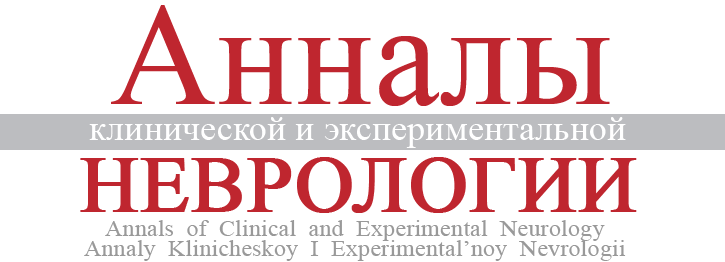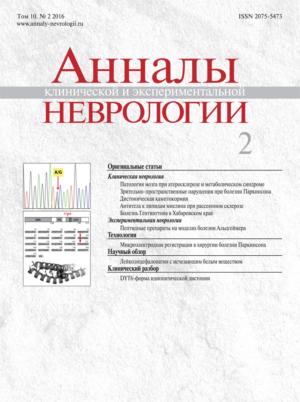Поздняя лейкоэнцефалопатия с исчезающим белым веществом
- Авторы: Руденская Г.Е.1, Захарова E.Ю.1
-
Учреждения:
- ФГБНУ «Медико-генетический научный центр им. Н.П. Бочкова»
- Выпуск: Том 10, № 2 (2016)
- Страницы: 46-51
- Раздел: Обзоры
- Дата подачи: 31.01.2017
- Дата публикации: 03.02.2017
- URL: https://annaly-nevrologii.com/journal/pathID/article/view/59
- DOI: https://doi.org/10.17816/psaic59
- ID: 59
Цитировать
Полный текст
Аннотация
Лейкоэнцефалопатия с исчезающим белым веществом (ЛЭ-ИБВ) – одна из частых наследственных лейкоэнцефалопатий с характерной МРТ-картиной диффузного поражения белого вещества с кистозной дегенерацией. Болезнь связана с генами EIF2B1–5, кодирующими пять субъединиц фактора инициации трансляции EIF2B. Выделяют младенческую, детскую (самую частую) и позднюю формы. Поздняя ЛЭ-ИБВ составляет 15–20% всех случаев и отличается выраженным клиническим разнообразием. Помимо неврологических и когнитивных расстройств, для данного заболевания характерна яичниковая недостаточность. В обзоре представлены клинические и молекулярно-генетические аспекты поздней ЛЭ ИБВ.
Об авторах
Галина Евгеньевна Руденская
ФГБНУ «Медико-генетический научный центр им. Н.П. Бочкова»
Email: rudenskaya@med-gen.ru
Россия, Москва
E. Ю. Захарова
ФГБНУ «Медико-генетический научный центр им. Н.П. Бочкова»
Автор, ответственный за переписку.
Email: rudenskaya@med-gen.ru
Россия, Москва
Список литературы
- Михайлова С.В., Захарова Е.Ю., Петрухин А.С. Нейрометаболические заболевания у детей и подростков. Диагностика и подходы к лечению. М.: Литтерра, 2012.
- Agorastos A., Huber C. Vanishing white-matter disease: a case of severe adult onset with prolonged course under anticonvulsive therapy. J. Neuropsychiat. Clin. Neurosci. 2012; 24: 24–25.
- Ahmed R., Murphy E., Davagnanam I. et al. A practical approach to diagnosing adult onset leukodystrophies. J. Neurol. Neurosurg. Psychiatry. 2014; 85: 770–781.
- Ayrignac X., Carra-Dalliere C., Menjot de Champfleur N. et al. Adultonset genetic leukoencephalopathies: а MRI pattern-based approach in a comprehensive study of 154 patients. Brain. 2015; 138 (Pt 2): 284–292.
- Biancheri R., Rossi A., Di Rocco M. et al. Leukoencephalopathy with vanishing white matter: an adult onset case. Neurology. 2003; 61: 1818–1819.
- Black D., Booth F., Watters G. et al. Leukoencephalopathy among native Indian infants in northern Quebec and Manitoba. Ann. Neurol. 1988; 24: 490–496.
- Boespflug-Tanguy O., Labauge P., Fogli A., Vaurs-Barriere C. Genes involved in leukodystrophies: a glance at glial functions. Curr. Neurol.Neurosci. Rep. 2008; 8: 217–229.
- Carra-Dalliere C., Horzinski L., Ayrignac X. et al. Histoire naturelle des leucodystrophies avec mutation EIF2B : etude retrospective multicentrique de 24 cas adultes. Rev. Neurol. (Paris). 2011; 167: 802–811.
- Damásio J., van der Lei H., van der Knaap M., Santos E. Late onset vanishing white matter disease presenting with learning difficulties. J. Neurol. Sci. 2012; 314: 169–170.
- Damon-Perriere N., Menegon P., Olivier A. et al. Intra-familial phenotypic heterogeneity in adult onset vanishing white matter disease. Clin. Neurol. Neurosurg. 2008; 110: 1068–1071.
- Denier C., Orgibet A., Roffi F. et al. Adult-onset vanishing white matter leukoencephalopathy presenting as psychosis. Neurology. 2007; 68: 1538–1539.
- Di Donato I., Banchi S., Federico A., Dotti M. Adult-onset genetic leukoencephalopathies. Focus on the more recently defined forms. Curr. Mol. Med. 2014; Oct 10 [Epub ahead of print].
- Dreha-Kulaczewski., Dechent P., Finsterbusch J. et al. Early reduction of total N-acetyl-aspartate-compounds in patients with classical vanishing white matter disease. A long-term follow-up MRS study. Pediatr. Res. 2008; 63: 444–449.
- Fogli A., Boespflug-Tanguy O. The large spectrum of eIF2B-related diseases. Biochem. Soc. Trans. 2006; 34 (Pt 1): 22–29.
- Fogli A., Rodriguez D., Eymard-Pierre E. et al. Ovarian failure related to eukaryotic initiation factor 2B mutations. Am. J. Hum. Genet. 2003; 72: 1544–1550.
- Fogli A., Schiffmann R., Bertini E. et al. The effect of genotype on the natural history of eIF2B-related leukodystrophies. Neurology. 2004;62: 1509–1517.
- Gallo A., Rocca M., Falini A. et al. Multiparametric MRI in a patient with adult-onset leukoencephalopathy with vanishing white matter.Neurology. 2004; 62: 323–326.
- Ghezzi L., Scarpini E., Rango M. et al. A 66-year-old patient with white matter disease due to the p.Ala87Val EIF2B3 mutation. Neurology. 2012; 79: 2077–2078.
- Herwerth M., Schwaiger B., Kreiser K. et al. Adult-onset vanishing white matter disease as differential diagnosis of primary progressive multiple sclerosis: a case report. Mult. Scler. 2015; 21: 666–668.
- Kanbayashi T., Saito F., Matsukawa T. et al. Adult-onset vanishing white matter disease with novel missense mutations in a subunit of translational regulator, EIF2B4. Clin. Genet. 2015; Jan 20 [Epub ahead of print].
- Klingelhoefer L., Misbahuddin A., Jawad T. et al. Vanishing white matter disease presenting as opsoclonus myoclonus syndrome in childhood – a case report and review of the literature. Pediatr. Neurol. 2014; 51: 157–164.
- Koga S., Sekiguchi Y., Kanai K. et al. Case of adult onset vanishing white matter disease developed after minor head trauma. Rinsho Shinkeigaku. 2012; 52: 561–566.
- Labauge P., Fogli A., Castelnovo G. et al. Dominant form of vanishing white matter-like leukoencephalopathy. Ann. Neurol. 2005; 58:634–639.
- Labauge P., Horzinski L., Ayrignac X. et al. Natural history of adult onset eIF2B related disorders: a multi-centric survey of 16 cases. Brain. 2009; 132: 2161–2169.
- La Piana R., Vanderver A., van der Knaap M. et al. Adult-onset vanishing white matter disease due to a novel EIF2B3 mutation. Arch. Neurol.2012; 69: 765–768.
- Leegwater P., Vermeulen G., Konst A. et al. Subunits of the translation initiation factor eiF2B are mutant in leukoencephalopathy with vanishing white matter. Nat. Genet. 2001; 29: 383–388.
- Maletkovic J., Schiffmann R., Gorospe J. et al. Genetic and clinical heterogeneity in eIF2B-related disorder. J. Child Neurol. 2008; 23:205–215.
- Mathis S., Scheper G., Baumann N. et al. The ovarioleukodystrophy. Clin. Neurol. Neurosurg. 2008; 110: 1035–1037.
- Matsukawa T., Wang X., Liu R. et al. Adult-onset leukoencephalopathies with vanishing white matter with novel missense mutations in EIF2B2, EIF2B3, and EIF2B5. Neurogenetics. 2011; 12: 259–261.
- Ohlenbusch A., Henneke M., Brockmann K. et al. Identification of ten novel mutations in patients with eIF2B-related disorders. Hum. Mutat. 2005; 25: 411.
- Ohtake H., Shimohata T., Terajima K. et al. Adult-onset leukoencephalopathy with vanishing white matter with a missense mutation in EIF2B5. Neurology. 2004; 62: 1601–1603.
- Pato A., González L., Cimas H., Rodríguez-Constenla I. Leukoencephalopathy with vanishing white matter: a clinical case of adult onset. Neurologia. 2009; 24: 504–505.
- Peter L., Niel F., Catenoix H. et al. Acute neurological deterioration in ovarioleukodystrophy related to EIF2B mutations: pregnancy with oocyte donation is a potentially precipitating factor. Eur. J. Neurol.2008; 15: 94–97.
- Prass K., Bruck W., Schroder N. et al. Adult-onset leukoencephalopathy with vanishing white matter presenting with dementia. Ann. Neurol. 2001; 50: 665–668.
- Ramaswamy V., Chan A., Kolski H. Vanishing white matter disease with periodic (paroxysmal) hemiparesis. Pediatr. Neurol. 2006; 35: 65–68.
- Scali O., Di Perri C., Federico A. The spectrum of mutations for the diagnosis of vanishing white matter disease. Neurol. Sci. 2006; 27: 271–277.
- Schiffmann R., Moller J., Trapp B. et al. Childhood ataxia with diffuse central nervous system hypomyelination. Ann. Neurol. 1994; 35:331–340.
- Schiffmann R., Tedeschi G., Kinkel R. et al. Leukodystrophy in patients with ovarian dysgenesis. Ann. Neurol. 1997; 41: 654–661.
- Sedel F., Tourbah A., Fontaine B. et al. Leukoencephalopathies associated with inborn errors of metabolism in adults. J. Inherit. Metab.Dis. 2008; 31: 295–307.
- Shimada S., Shimojima K., Sangu N. et al. Mutations in the genes encoding eukaryotic translation initiation factor 2B in Japanese patients with vanishing white matter disease. Brain Devel. 2015; Apr 2 [Epub ahead of print].
- Tedeschi G., Schiffmann R., Barton N. Proton magnetic resonance spectroscopic imaging in childhood ataxia with diffuse central nervous system hypomyelination. Neurology. 1995; 45: 1526–1532.
- Turón-Vinas E., Pineda M., Cusí V. et al. Vanishing white matter disease in a Spanish population. Cent. Nerv. Syst. Dis. 2014; 6: 59–68.
- Van der Knaap M., Barth P., Gabreels F. et al. A new leukoencephalopathy with vanishing white matter. Neurology. 1997: 48: 845–855.
- Van der Knaap M., Bugiani M., Boor I. et al. Vanishing white matter. In: Valle D. et al. (Eds). Metabolic and Molecular Bases of Inherited Disease. NY, 2010.
- Van der Knaap M., Leegwater P., Konst A. et al. Mutations in each of the five subunits of translation initiation factor eIF2B can cause leukoencephalopathy with vanishing white matter. Ann. Neurol. 2002; 51: 264–270.
- Van der Knaap M., Leegwater P., van Berkel C. et al. Arg113His mutation in eIF2Bepsilon as cause of leukoencephalopathy in adults. Neurology.2004; 62: 1598–1600.
- Van der Knaap M., Pronk J., Scheper G. Vanishing white matter disease. Lancet Neurol. 2006; 5: 413–423.
- Van der Knaap M., Scheper G. Non-eIF2B-related cystic leukoencephalopathy of unknown origin. Ann. Neurol. 2006; 59: 724.
- Van der Lei H., van Berkel C., van Wieringen W. et al. Genotypephenotype correlation in vanishing white matter disease. Neurology. 2010; 75: 1555–1559.
- Wu Y., Pan Y., Du L. et al. Identification of novel EIF2B mutations in Chinese patients with vanishing white matter disease. J. Hum. Genet.2009; 54: 74–77.
Дополнительные файлы








